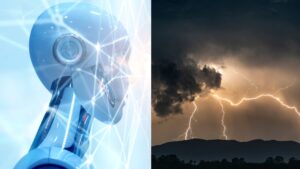Neural networks excel at day-to-day forecasting—but falter when facing rare, extreme weather
As the world increasingly relies on artificial intelligence for weather prediction, a new study led by the University of Chicago has uncovered a critical limitation: neural networks fail to anticipate so-called “gray swan” weather events rare but devastating occurrences that may not appear in the historical data used to train these AI systems.
Published in the Proceedings of the National Academy of Sciences on May 21, the study reveals that although AI models offer fast and energy efficient forecasts, they struggle to predict unprecedented weather phenomena such as 200-year floods, record-breaking heat waves, or catastrophic hurricanes.
 What Are Gray Swan Events?
What Are Gray Swan Events?
Unlike typical day-to-day variations in weather gray swan events lie just outside the spectrum of past experience. They are extreme, plausible and potentially regionally devastating, yet rare enough to be underrepresented or entirely absent in the historical datasets that power most machine-learning models.
In this study, researchers focused on hurricanes to explore how neural networks respond to such outlier scenarios. They trained a model using decades of weather data but intentionally excluded hurricanes stronger than Category 2. When they later fed the model conditions that typically result in a Category 5 hurricane, the AI consistently failed to predict anything above a Category 2.
The result: systematic underestimation. The model recognized that a storm was forming but could not foresee its true strength revealing a potentially dangerous shortcoming for real-world forecasting and emergency response planning.
Limits of AI Forecasting
Modern neural networks have revolutionized short-term weather forecasting, matching the accuracy of traditional, physics-based weather models while consuming a fraction of the time and computing power. However, this new research underscores that AI forecasts are only as good as their training data.
The crux of the issue lies in how these models function. Like language models that predict text based on previously seen words, weather AIs analyze past meteorological patterns to forecast future ones. This approach works well for routine predictions but fails when confronted with never-before-seen scenarios.
Since comprehensive, high-resolution global weather records only span around 40 years, the models lack examples of rare but plausible events. This leaves them blind to certain catastrophic possibilities especially at regional levels.
Physics vs. Pattern Recognition
Traditional weather models are built on the laws of physics, incorporating fluid dynamics, thermodynamics, and other governing principles of atmospheric behavior. In contrast, AI models operate more like high-powered pattern recognizers. While efficient, they don’t inherently understand the physical mechanics that drive weather systems.
This distinction becomes particularly important for extreme weather. A traditional model might infer the potential for a Category 5 hurricane by analyzing jet streams, sea surface temperatures, and atmospheric pressure patterns. A neural network, however, would only guess based on what similar inputs have led to in the past—which might not include anything stronger than a Category 2 storm.
A Promising Path Forward
Despite these limitations, the study offers hope. The researchers found that if a neural network had access to similar extreme events even if they occurred in a different region it could extrapolate to make better predictions elsewhere.
For example, if the training data excluded all Atlantic Category 5 hurricanes but included such events from the Pacific, the model could successfully predict strong Atlantic storms. This suggests that AI models can generalize extreme events if given a broader and more diverse dataset.
The team proposes a solution: hybrid forecasting systems that combine the strengths of AI and physics-based modeling. By integrating mathematical tools and physical principles into machine learning frameworks, scientists could help AIs “understand” atmospheric dynamics and extend their predictive range.
One such approach is called active learning, where AI is used to identify areas of uncertainty in traditional models, which can then generate new synthetic data to train better-performing networks especially for edge-case scenarios.
Preparing for an Uncertain Climate Future
As climate change fuels more frequent and more severe extreme weather events, forecasting systems must evolve. Neural networks offer immense promise, but their current limitations could hinder preparedness and response to the very disasters we most need to anticipate.
This study, conducted in collaboration with New York University and the University of California Santa Cruz, emphasizes that while AI weather models are among the most impressive achievements in scientific AI, they are not infallible.
Improving their ability to forecast gray swans may require a fundamental shift in how we design and train these tools blending data science with domain knowledge and drawing on the very physics that shape our skies.
